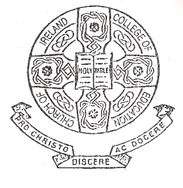Church of Ireland College of Education
|
Coláiste Oideachais Eaglais na hÉireann | |
 CICE Logo | |
Former names | The Kildare Place Training Institution, Church of Ireland College |
|---|---|
| Motto | Pro Christo Discere Ac Docere |
Motto in English | To learn and teach on behalf of Christ |
| Type | Church of Ireland |
| Established | 1811 |
| Principal | Dr. Anne Lodge |
| Location | Rathmines, Dublin, Ireland |
| Affiliations | University of Dublin |
| Website | www.cice.ie |
The Church of Ireland College of Education or C.I.C.E. as it was more commonly known (Irish: Coláiste Oideachais Eaglais na hÉireann) was one of five Irish Colleges of Education which provided a Bachelor of Education (B.Ed.) degree, the qualification generally required to teach in Irish primary schools. Its degrees were awarded by Trinity College/University of Dublin just like Marino Institute of Education and Froebel College of Education. The college was located in Rathmines in Dublin.
The College also provided postgraduate courses in Learning Support and Special Educational Needs and a Certificate Course for Special Needs Assistants.
As of October 1st 2016 the college has been incorporated into Dublin City University.
History
The history of The Church of Ireland College of Education dates from 1811 when a primary teacher training college known as The Kildare Place Training Institution was founded in Dublin by the Society for Promoting Education of the Poor in Ireland. In the 1850s this institution was taken over by the Church Education Society for the purpose of training Anglican teachers for church schools. This College was taken over in 1878 by the General Synod of the Church of Ireland and six years later became a recognised denominational college with the Archbishop of Dublin as ex officio manager and Chairman of the Board of Governors. In 1884 under the guidance of Archbishop Plunket affiliated to the state national school system.[1]
In the 1970s a Bachelor of Education degree was introduced and since then has been taught jointly by Trinity College, University of Dublin and The Church of Ireland College of Education. It is also the oldest teacher training establishment in Ireland. While it holds the fewest students in comparison to the other colleges, it is renowned for its esteemed graduates.[2]
The CICE course had a mandatory religious element preparing teachers to teach in Protestant run primary schools.[3] Student accommodation was also available on campus for both students of the college or of other colleges.
In 2011 the college celebrated its bicentenary, with a number of events celebrating the college's contribution to education in Ireland.[4]
2012 saw announcements by the Minister of Education, Ruairi Quinn, regarding the reduction in the number of teacher training colleges, with a number of small colleges earmarked for closure or encouraged to merge with other institutions. Following this, the board of governors, including the principal, Anne Lodge and the Archbishop of Dublin, Michael Jackson, ended the historic link with Trinity College, and entered into negotiations with Dublin City University where CICE was fully incorporated on October 1st 2016. [5] This proved incredibly controversial, and many people including former CICE governors and leading Church of Ireland members believed that the college was closed without adequete consultation from the archbishop and the principal.[6]
The new DCU Institute of Education comprises DCU's own Education Dept, CICE, Mater Dei Institute and St Patrick's College, Dublin (Drumcondra).[7] The college's religious element is overseen within DCU by the new Church of Ireland Centre (CIC) headed up by Anne Lodge, the final Principal of CICE.
Principals
Principals of the College included:-
- Canon Henry Kingsmill Moore DD (1884-1927) - First Principal
- Rev. Evelyn Hodges (1928 to 1942),
- Canon R.J. Ross, MA.
- Dr. Kenneth Milne (1975-1984),
- Mr. Sydney Blain (1984-2009),
- Anne Lodge[8] - Final Principal
External links
References
- ↑ Plunket, William Conyngham Oxford Dictionary of Biography, Oxford University Press.
- ↑ Church of Ireland College of Education (Ireland) Archived 13 January 2008 at the Wayback Machine. - Colleges of the Anglican Communion
- ↑ Do teachers have religious freedom? Irish Times, Tuesday 30 November 2010.
- ↑ Church of Ireland College of Education Bicentenary Celebrations Dublin & Glendalough Diocese Webpage, April 2011
- ↑ https://www.ireland.anglican.org/news/4323/statement-on-behalf-of-the
- ↑ https://www.irishtimes.com/news/social-affairs/religion-and-beliefs/staff-and-students-at-former-church-of-ireland-college-protest-1.2952755
- ↑ Church and TCD in row over teacher training by Seán Flynn, Education Correspondent, Irish Times, Friday 7 December 2012.
- ↑ New Principal of the Church of Ireland College of Education dublin.anglican.org, July 2009.
Coordinates: 53°19′07″N 6°15′41″W / 53.318538°N 6.261322°W